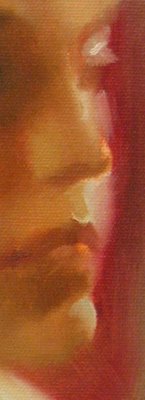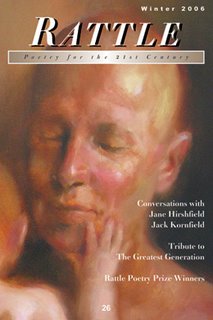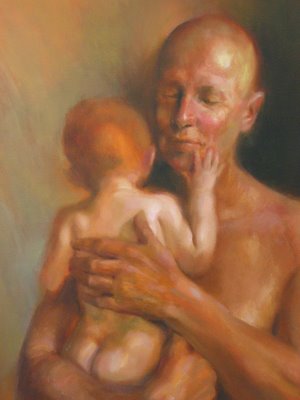
Earlier this year I did a portrait demonstration for an audience of about fifty people at the Fine Artists Factory in Pasadena, California.
I photographed each stage and wanted to share them with those of you who love the way oilpaint can communicate flesh, depth and light. For artists, this kind of painting experience is akin to savoring a meal, enjoying taste after taste. It is also like meditating on music, focusing on the way each note relates to the overall impact upon a listener's nervous system. Done in the privacy of a studio, painting can feel relaxing or even painstakingly controlled. But performed in front of a crowd as an instructional process while speaking, a certain directness must rule. Add to that the strict time limit of two hours, and the experience becomes heart pounding.

I had Toni, one of the top figure models in Los Angeles pose for me. Afer laying in a transparent wash of alizarin crimson, yellow ochre and a touch of ivory black, I began a loose drawing with a brush focusing on large proportions and structure. Because I will be painting with big shapes and masses of color, the drawing does not need to be refined. In fact, a precise drawing would create a different kind of painting experience for me, forcing me to tiptoe around the portrait. About ten minutes was spent on the drawing here, with me describing every observation.
For my palette I am using only four tubes of paint: Alizarin Crimson, Yellow Ochre, Ivory Black and Titanium White Classico Oil Paint.I am using a big #12 Brush.

I begin with what I consider the most difficult passage in the portrait: the eye-socket in shadow. Dealing with these darks and middle valued areas will help me create the large masses that carry much of the image. I save the lights for last, leaving the canvas blank in these aresa until I am ready for them. The beginning stages of laying in my big shapes is always a rush for me. The painting always appears strange to my eye, but in my mind I can visualize the final outcome even from these early few strokes of paint. As I squint, each area on Toni's face is carefully observed, related to an adjacent value and translated by me as a plane. Each plane is then translated as a brushstroke.




It's been about fifteen minutes of painting, and the audience (and I) all breathe a sigh of relief... The hardest passages are done. I can continue with confidence that the overall structure is working, and that the delicate reflective light is being communicated. Notice how the features are not detailed in any way at this stage.

Now I boldly lay in the darks of the hair, and paint the way the hair relates to the darkness of the background. As I do this, the audience gives a collective "Ahhh!"
The darkness causes the reflective light on the face to take on it's luminous character. The face is primarilly middle value!

Time for a ten minute break. The model stretches and I prepare for the next sitting. Total painting time so far: thirty minutes.

More airy background and a burst of alizarin crimson to enliven the glow of the light hitting the far side of the face. I do not sense a cut out hard-edged contour back there...
I am a Venetian painter at heart when I paint this way. Washes, unrefined passages, free color effects and varied edges are my choices.


I develop the chest and neck area...
The "greens" in the flesh are actually yellow ochre, black and white.
The "blues" in the background are actually just mixtures of black and white.

Time to move throughout the rest of the painting...and then return to the face to give her complexity and definition. The background, the hair, the arm, dress and expressive hand all develop quickly and simply. The blending of edges is very important. As you can see, I use precious few hard edges in my work. Finally everything begins to "fuse" as the unified image I intended.

Near the end, I address the drawing one final time. (Every stroke is "drawing"), but now it's time to pull out a smaller brush and be precise where needed. I carefully reshape the chin ...

I create the hand with masses and shapes. Then, with a few dashes of line, fingers are suggested. I let the thumb merge into the chest to keep the area from getting too liney. I have fun with the diminishing pinky. The dress and the anatomy of the arm come with refinement from a small brush.
Only now do I prepare for the adding of the lights.


This thin strip along the far side of the face is my true focal point, the area of clarity. A combination of crisp strokes floating in a soft haze of light will create depth, suggest the features and remain consistent with the rest of the painting. My goal here is to not impress the viewer with how much work I have done, but rather, how much work I
refrained from doing to create her expression and sense of life.

[
In the Light by John Paul Thornton]
After describing every stroke and subtle smear, I finish with a final highlight on her eyelid. My patient audience cheers. I wipe the sweat from my own brow. It's been two hours from the initial laying down of my wash. I sign the painting. Time for a beer.




















